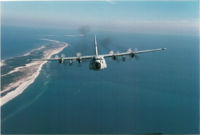PlaneSpottingWorld welcomes all new members! Please gives your ideas at the Terminal.
Lockheed WC-130
The WC-130 Hercules is a high-wing, medium-range aircraft flown by the Air Force Reserve Command for weather reconnaissance missions.
Features
The WC-130 is capable of staying aloft nearly 15 hours during missions. It is equipped with two external 1,400 US gallon (5,300 L) fuel tanks, an internal 1,800 US gallon (6,810 L) fuel tank, and has uprated engines. An average weather reconnaissance mission might last 11 hours and cover almost 3,500 miles (5,600 km) while the crew collects and reports weather data every minute. Weather equipment aboard the aircraft include the Improved Weather Reconnaissance System (IWRS). This system consists of the Atmospheric Distributed Data System (ADDS) and Omega Dropsonde Windfinding System (ODWS).
The ADDS system provides a high-density, high-accuracy horizontal atmospheric sensing capability. Sensors installed on the aircraft measure per second outside temperature, humidity, absolute altitude of the aircraft, pressure altitude, wind speed and direction. This information, along with an evaluation of other meteorological conditions, turbulence, icing, radar returns and visibility, is encoded by the onboard meteorologist and transmitted by satellite to the National Weather Services' National Hurricane Center in Miami, Florida.
The ODWS system measures the atmosphere vertically by using an expendable instrument which is dropped from the aircraft. The 16 inch (406 mm) long cylinder is dropped every 400 miles (640 km) while on a weather track and in the center or hurricane eye. A vertical atmospheric profile of pressure, temperature, humidity, barometric pressure, wind speed and direction is received from the dropsonde as it descends to the ocean surface. The dropsonde is slowed and stabilized by a small parachute. From this information, the dropsonde system operator analyzes and encodes data for satellite transmission to the National Hurricane Center.
The WC-130 is flown exclusively by the 53rd Weather Reconnaissance Squadron, an Air Force Reserve Command organization known as the Hurricane Hunters, based out of Keesler Air Force Base, Mississippi. The hurricane reconnaissance area includes the Atlantic Ocean, Caribbean Sea, Gulf of Mexico and eastern Pacific Ocean areas.
Background
The WC-130 Hercules is a modified version of the C-130 transport configured with computerized weather instrumentation for penetration of severe storms to obtain data on storm movements, dimensions and intensity. The WC-130B was operational from 1962 to 1979, the E model from 1965 to 1993, followed by the H model from 1973 to 2005. Only the J model, introduced in 1999, is currently in operation as of 2006. Three WC-130A models were operational in South East Asia from 1967 to 1970.
The WC-130 provides vital tropical cyclone forecasting information. It penetrates tropical cyclones and hurricanes at altitudes ranging from 500 to 10,000 feet (150 to 3,000 m) above the ocean surface depending upon the intensity of the storm. The aircraft's most important function is to collect high-density, high-accuracy weather data from within the storm's environment. This includes penetration of the center or hurricane eye of the storm. This vital information is instantly relayed by satellite to the National Hurricane Center to aid in the accurate forecasting of hurricane movement and intensity.
General characteristics
- Crew: Five; pilot, co-pilot, navigator, aerial reconnaissance weather officer and loadmaster
- Length: 99 ft 4 in (30.1 m)
- Wingspan: 132 ft 6 in (40 m)
- Height: 38 ft 6 in (11.7 m)
- Wing area: ft² (m²)
- Empty weight: lb (kg)
- Max takeoff weight: 155,000 lb (69,750 kg)
- Powerplant: 4× Four Rolls-Royce AE 2100D3 turboprops Dowty R391,6-Blade All Composite Propellers, 4,700 shp (kW) each
Performance
- Maximum speed: 417 mph/362 ktas (Mach 0.59) at 22,000 feet (6,706 meters) (km/h)
- Range: 2,071 miles (1,800 nautical miles) (3,700 n.mi. / (km)
- Service ceiling: 28,000 feet (8,615 meters) with 42,000 pounds (19,090 kilograms) payload (m)
- Rate of climb: ft/min (m/s)
- Wing loading: lb/ft² (kg/m²)
- Power/mass: hp/lb (kW/kg)
References
- USAF Website WC-130
- USAF Website C-130J
- WHISKEY-CHARLIE!
- Lockheed Martin C-130 Hurcules Specifications
External links
- C-130J “Hurricane Hunters” fly record season
- Last WC-130H departs Keesler
- Lockheed WC-130
- Motor Pool Gallery
Related content
Related development
Comparable aircraft
WP-3D
WC-135
Related lists
List of Lockheed aircraft
Lists relating to aviation | |
|---|---|
| General | Timeline of aviation · Aircraft · Aircraft manufacturers · Aircraft engines · Aircraft engine manufacturers · Airports · Airlines |
| Military | Air forces · Aircraft weapons · Missiles · Unmanned aerial vehicles (UAVs) · Experimental aircraft |
| Notable incidents and accidents | Military aviation · Airliners · General aviation · Famous aviation-related deaths |
| Records | Flight airspeed record · Flight distance record · Flight altitude record · Flight endurance record · Most produced aircraft |

